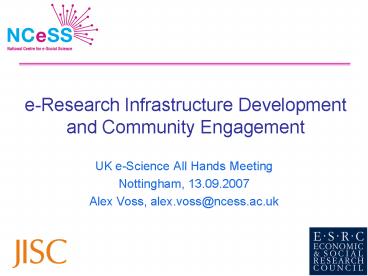eResearch Infrastructure Development and Community Engagement - PowerPoint PPT Presentation
1 / 18
Title:
eResearch Infrastructure Development and Community Engagement
Description:
Common approach to evidence gathering, similar analytic ... Sociotechnical alignment. Path dependencies - lock-in. Uneven distribution of costs & benefits ... – PowerPoint PPT presentation
Number of Views:32
Avg rating:3.0/5.0
Title: eResearch Infrastructure Development and Community Engagement
1
e-Research Infrastructure Development and
Community Engagement
- UK e-Science All Hands Meeting
- Nottingham, 13.09.2007
- Alex Voss, alex.voss_at_ncess.ac.uk
2
Community Engagement
- Two related JISC projects, started April07
- Funded under the e-Infrastructure programme
community engagement strand - Aimed at widening uptake of e-Infrastructures
- Common approach to evidence gathering, similar
analytic approaches but different outputs /
interventions
3
Understanding Widening Uptake
- Drawing on science and technology studies
- Early adopters - followers - late adopters (Not
character types) - Mutual shaping
- Sociotechnical alignment
- Path dependencies - lock-in
- Uneven distribution of costs benefits
- User-designer relations
- Designing interventions
- Based on understanding of drivers / barriers /
enablers / alignment / beaten paths
4
e-Uptake
- Enabling Uptake of e-Infrastructure Services
5
Immediate Aims
- Consolidate understanding of user needs
- Identification of gaps in the training support
needed - Run training, education and outreach events
across disciplines - Create a repository of event information, support
information and learning material
6
Longer term
- Recommendations on how responses to barriers
might be sustained and funded in the future - Foster ongoing dialogue between service and
technology providers, application developers and
research communities
7
Analysis
- Of barriers to uptake as well as enablers
- Through document reviews and fieldwork
(interviews, surveys or direct observation) - Static, linear description is not adequate as
there is no one typology of issues - Searchable along a number of dimensions
(typologies and tags) through a web interface - Better recipient design
8
Intervention
- Through Training, Education and Outreach (TOE)
Activities - Series of workshops and training events in
different application areas - Development of training and support material for
these communities - UK one-stop-shop event information, support
material and support contacts - Crucially federation to community sites (e.g.,
NCeSS, AHeSSC)
9
Stakeholder Involvement
- Support through the communities of service
providers, technology developers and users (of
various stripes) is essential - Review workshops to validate findings
- Overlap with other activities exists and creates
additional requirements but also opportunities - Aim is to foster an ongoing discourse that will
last longer than the project itself
10
- e-Infrastructure Use Cases and Service Usage
Models
11
Outputs
- Capturing patterns of use
- Transferable
- Inspiring examples
- Three different, but related outputs
- Experience Reports
- Use Cases
- Service Usage Models
- Key word here is traceability
- Easily searchable and consumable by stakeholders
12
Collecting Evidence
- Gathering experience reports
- Semi-structured interviews guided by an interview
framework. - Identifies research area, research tasks, and
tools and technologies used - Fieldwork and producing short ethnographies of
practice - E.g. production of video vignettes
- Resource constraints practical agenda
13
Use Cases
- Engaging stories about e-Infrastructure usage,
tied back to more concrete experience reports - Generalise over experience reports
- Make usage patterns more user friendly and
transferable
14
Use Cases Example
15
Community Process
- Important aspect to achieve sustainability
- OSSwatch consultation explored the idea of
forming a community around eIUS and e-Uptake. - Users
- Contributors
- Committers
16
Stakeholder Benefits
- Potential benefits to Service Providers
- Input for their own requirements analysis and
user engagement activities - More publicity for their services
- Get at how researchers use a particular service
- Understanding of how researchers join up services
to achieve a particular goal
17
Stakeholder Benefits (II)
- Potential benefits for researchers
- Learn about ways of using e-Infrastructure
- Find out what key decisions need to be made
- Find contacts peers, support, training
- Tell service providers about their ways of using
e-Infrastructure
18
Summary / Outlook
- Understand uptake as a complex social process
- Enable uptake through more targeted interventions
- Foster developments within communities rather
than just offering technologies to them. - Initial review and conceptual work and piloting
of fieldwork - Now developing strategies for the next stage,
evidence gathering - Work on technical outputs and planning events
- Next presentation e-Social Science 07 _at_ Ann
Arbor, 7th-9th October (http//ess.si.umich.edu)































